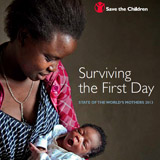
More than 1 million babies die on the first day of life – making the birth day the most dangerous day for babies in nearly every country, rich and poor alike. This is one of the major findings of Save the Children’s 14th annual State of the World’s Mothers report. The findings indicate, as never before, that helping babies survive the first day – and the first week – of life represents the greatest remaining challenge in reducing child mortality and meeting the ambitious Millennium Development Goal of reducing 1990 child mortality rates by two-thirds by 2015.
The world has made unprecedented progress since 1990 in reducing maternal and child deaths. Working together, governments, communities, nongovernmental organizations and families have reduced the annual number of children under 5 who die each year by over 40 percent – from 12 million to 6.9 million. Progress for mothers has been even greater, with deaths declining almost 50 percent since 1990 – from 543,000 to 287,000 per year. But we have made much less progress for the children who are the most vulnerable of all – newborns. In 2011, 3 million babies died in their first month of life. This is 43 percent of all deaths of children under age 5 worldwide. Three-quarters of those newborns died in the first week of their lives, and one-third did not survive their first day of life.
Why such slow progress in reducing newborn deaths? One reason is that until recently many believed – incorrectly – that little could be done to save newborn lives in the poorest countries. We now know that newborn deaths are not inevitable and that low-income countries can make significant progress in reducing newborn mortality. We have identified the three major causes of these deaths – complications during birth, prematurity and infections – and we have developed a set of interventions that can prevent or treat each of these causes. These proven interventions – coupled with stronger health systems and sufficient health care workers who are trained, deployed and supported to tackle the key causes of child mortality – have the potential to reduce newborn deaths by as much as 75 percent. This would save more than 2 million newborn lives each year. Ending preventable deaths within a generation will require an increased focus on the steps needed to reduce newborn mortality. What is lacking is the political will and funding to deliver these solutions to all the mothers and babies who need them.
This year’s State of the World’s Mothers report shows which countries are succeeding – and which are failing – in saving the lives of mothers and their newborn babies. It examines the ways investments in health care, nutrition and education can make a difference for newborns, mothers, communities and society as a whole. It also points to proven, low-cost solutions that could save millions of lives if used by all mothers and newborns.